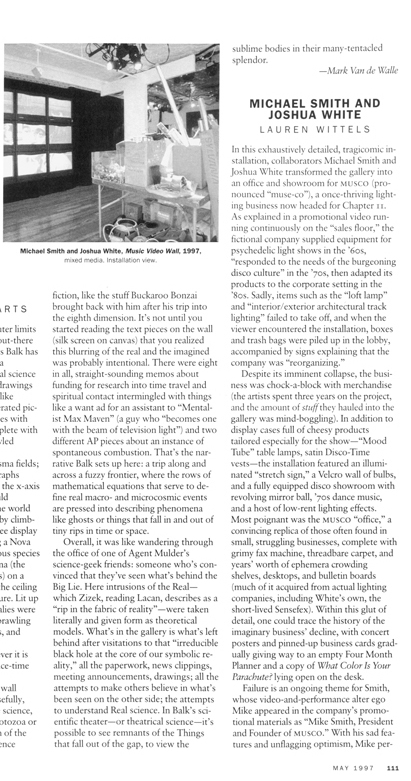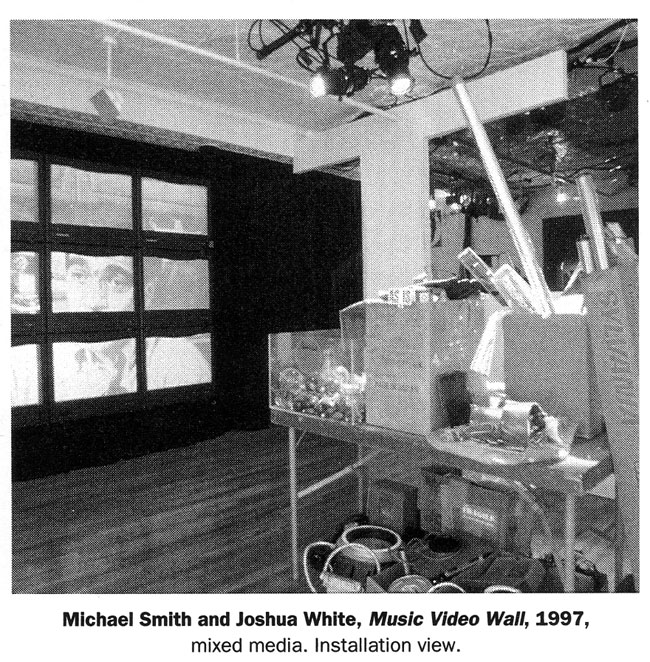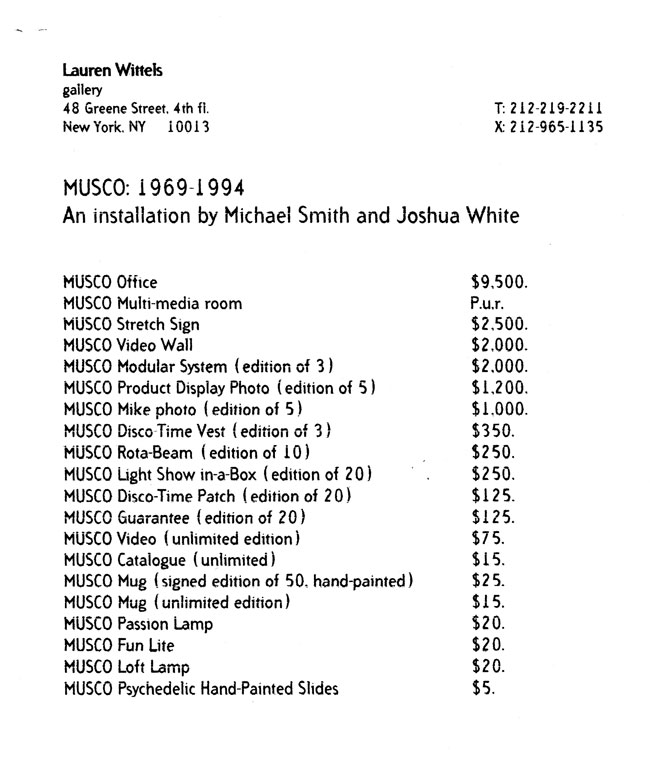 |
 |
New York Reviews, Artforum, May 1997
Michael Smith and Joshua White
LAUREN WITTELS
In this exhaustively detailed, tragicomic installation, collaborators Michael Smith and Joshua White transformed the gallery into an office and showroom for MUSCO (pronounced “muse-co”), a once-thriving lighting business now headed for Chapter 11. As explained in a promotional video running continuously on the “sales floor,” the fictional company supplied equipment for psychedelic light shows in the ’60s, “responded to the needs of the burgeoning disco culture” in the ’70s, then adapted its products to the corporate setting in the ’80s. Sadly, items such as the “loft lamp” and “interior/exterior architectural track lighting” failed to take off, and when the viewer encountered the installation, boxes and trash bags were piled up in the lobby, accompanied by signs explaining that the company was “reorganizing.”
Despite its imminent collapse, the business was chock-a-block with merchandise (the artists spent three years on the project, and the amount of stuff they hauled into the gallery was mind-boggling). In addition to display cases full of cheesy products tailored especially for the show -- “Mood Tube” table lamps, satin Disco-Time vests -- the installation featured an illuminated “stretch sign,” a Velcro wall of bulbs, and a fully equipped disco showroom with revolving mirror ball, ’70s dance music, and a host of low-rent lighting effects. Most poignant was the MUSCO “office,” a convincing replica of those often found in small, struggling businesses, complete with grimy fax machine, threadbare carpet, and years’ worth of ephemera crowding shelves, desktops, and bulletin boards (much of it acquired from actual lighting companies, including White’s own, the short-lived Sensefex). Within this glut of detail, one could trace the history of the imaginary business’ decline, with concert posters and pinned-up business cards gradually giving way to an empty Four Month Planner and a copy of What Color Is Your Parachute? lying open on the desk.
Failure is an ongoing theme for Smith, whose video-and-performance alter ego Mike appeared in the company’s promotional materials as “Mike Smith, President and Founder of MUSCO.” With his sad features and unflagging optimism, Mike personifies the small businessman who is unaware that the greatest obstacle he faces is his own deeply ingrained mediocrity. The products he developed for MUSCO cut corners imaginatively as well as financially -- for example, a “video wall” of fake monitors slapped over a washed-out, rear-projected image -- and he lacks the vision to see the techno/rave scene as his salvation in the ’90s (according to Smith, alter ego Mike is aware of the trend but just doesn’t connect with it).
The installation became more complex when one realized that Smith’s collaborator, Joshua White, is the real-life creator of the Joshua Light Show at the Fillmore East in the ’60s. In the MUSCO fiction Joshua and Mike are partners (a doctored photo shows them shaking hands, ca. 1969), but in reality White got out of the light-show business in the early ’70s and became a successful television director, shooting everything from National Geographic Explorer to Seinfeld. Although he appears from his résumé to be a newcomer to installation, his inside knowledge of the lighting business -- and life, at least to a point -- brought layers of authenticity to Smith’s typical, total-immersion environment. One wonders what perverse instinct prompted White to envision a twenty-five-year partnership with a fictional loser (morphed into his past like a low-tech Forrest Gump), but in any event, the collaboration worked, fusing the decline of ’60s idealism and the downside of the American dream into a spectacle at once depressing and hilarious.
—Tom Moody

Some anecdotal background on the above review:
It appeared verbatim in Artforum's May 1997 issue except for one goof by the editor (Eric Banks, currently director of of the New York Institute for the Humanities -- more on him below), which I corrected here: in paragraph four "Joshua and Mike" appeared as "Joshua and White." Forrest Gump probably also didn't need italics (my mistake).
Several things struck me as "off" about the show that I didn't have space to develop. First, moving all this banal retail stuff into the gallery was truly a monumental effort but the illusion of an actual going business on the skids was only really maintained in one room: the carpeted office I mentioned. Elsewhere the floors were the gallery's standard polished wood, with the tasteful overhead track lighting still in place. Thus, you could never sink into the illusion that you were inside a struggling business (albeit with in-joky merchandise) and were constantly aware of the incongruity of "high" and "low" class markers -- the photo accompanying the review captures this somewhat.
A Frieze review concluded its description of the work by calling it a metaphor for modernity, in the sense, I guess, of its dazzling promise and threadbare delivery. That's a good point but, due to the incongruities mentioned above, I'm still not sure the show rose to the level of a metaphor. An earlier collaboration of Smith's called World of Photography (with William Wegman) fairly successfully laid waste to the assumptions of an entire medium (professional photography), whereas disco lighting is perhaps not as meaty a topic.
The Village Voice called the show "doubly ironic" because "it recreate[d] exactly the kind of small business that might have existed in Soho before art galleries pushed it out." Another good point, again, if traces of the gallery could have been eliminated from the recreation of the business.
Another "off" thing about the show was the nature of the partnership. Michael Smith was a well-known artist with a yard-long resume in performance, installation and video; White didn't have any art world credentials to speak of but was famous for other pursuits. Possibly after his start in providing rock concert visuals with the Joshua Light Show at the Fillmore, he always considered himself an artist, even after he left the lighting business and went and worked for The Man as a TV director. I interviewed him while making notes for the review and didn't delve into this awkward area. But in the editing process Banks wanted to know "What is White's stake in all this?", which led me to wonder the same thing in the final paragraph of the review. (I think it hit a nerve: after the review came out I met White again and got a rather frosty reception.)
Even more (cynical Manhattanite) speculation: I wondered at the time if White was a "backer" in the relationship. Smith was art world famous but not a big seller. Was White providing financial aid in exchange for a late start of an art resume? After the MUSCO show Smith and White did a few other collaborative exhibits. One at the New Museum recreating Mike's Soho loft was almost all Mike, content-wise; White's contribution was barely discussed in the press materials. The MUSCO show provided the first and possibly only valid point of conjunction between these individuals: Smith's fictional loser life and art world cred melded with White's real life business failure and possibly financial contribution as a result of later material success in corporate culture (TV).
Yet another "off" thing was the fiction of the failing business. Shouldn't the rave scene have revived it in the '90s, when this exhibition occurred? In our interview White said the collaborators had kicked around a performance idea where square retailer Mike was approached by some pierced glow stick kids and he told them to get out of the store. When I ran this by Smith he said "absolutely not -- Mike wouldn't have been hostile to ravers" and provided the quote about Mike just not connecting with that scene. (Smith's video persona may be a goofy sad sack but he has a strictly-business demeanor when talking about his character, a la Paul Reubens and Pee Wee Herman).
In an Artforum review, once you're done with the description, you have one more paragraph to sum up. Hopefully these notes have fleshed out the review (23 years later when it doesn't matter).

scan of price list
